Canon EOS 30DBy: Shawn Barnett and Dave EtchellsMyriad minor feature and interface tweaks make a great SLR even better. <<Video, Power, Software :(Previous) | (Next): Reference: Datasheet>> Page 12:Test Results & ConclusionReview First Posted: 04/14/2006 |
We ran the Canon EOS 30D through our usual battery of tests, and have summarized our findings here. To see the full set of our test images, with explanations of what to look for in them, see the Canon EOS 30D Sample Pictures page. For a complete listing of all our test and "gallery" shots, go to the Thumbnails page.
Not sure which camera to buy? Let your eyes be the ultimate judge! Visit our Comparometer(tm) to compare images from the EOS 30D with those from other cameras you may be considering. The proof is in the pictures, so let your own eyes decide which you like best!
Lens
The Canon EOS 30D accommodates an extremely wide range of Canon lenses, so performance here will depend entirely on the lens in use. (Hence, no results reported in this section.)
Sensor
Exposure and White Balance
Indoors, incandescent lighting
Poor performance from the Auto white balance setting, but good color balance with the Manual and 2900K settings, and good exposure as well.
| Auto White Balance +1.0 EV | Incandescent WB +1.0 EV |
| Manual White Balance +1.0 EV | 2,900K WB +1.0 EV |
The EOS 30D's Manual white balance setting responded very well to the tough incandescent lighting on this shot, but the 2900K setting was perhaps a bit truer to the warmth of the original scene. The Auto and Incandescent settings produced rather warm casts. On a Pro-oriented camera like the 30D, you'd expect the Incandescent setting to be color balanced for the 3200K of studio lights, so a warm cast there isn't too surprising. We really expect more from the Auto white balance of a camera in this price/performance range though. The EOS 30D required a +1.0 EV exposure compensation boost for the best looking exposure, which is pretty much average for this shot. Overall color looks very good here, though the blue flowers appear very dark and purplish. (A very common outcome for this shot.) Our test lighting for this shot is a mixture of 60 and 100 watt household incandescent bulb, a pretty yellow light source, but a very common one in typical home settings here in the US.
Outdoors, daylight
Very good color balance and exposure accuracy outdoors.
| Auto White Balance, Auto Exposure | Auto White Balance, Auto Exposure |
The EOS 30D produced very good-looking images outdoors, even under harsh lighting conditions. Though highlights were slightly blown out, detail remained good in both highlights and shadows. Color balance was very good, with vibrant hues.
See full set of test images with explanations
See thumbnails of all test and gallery images
Resolution
High resolution, 1,500-1,650 lines of strong detail.
Our laboratory resolution chart revealed sharp, distinct line patterns down to about 1,500 lines per picture height vertically and 1,650 horizontally, with extinction occurring somewhere past 2,000. Use these numbers to compare with other cameras of similar resolution, or use them to see just what higher resolution can mean in terms of potential detail. Beware that while you might be able to make out what looks like distinct lines at numbers higher than those we've mentioned here, the camera is just doing its best to continue interpreting the lines. If you zoom in and follow them from the wider portions, you'll see the lines shrink and grow in width considerably, due to aliasing, eventually converging and reappearing several times, so the lines you see at 1,800 and higher are really only artifacts generated by the camera's imaging system.
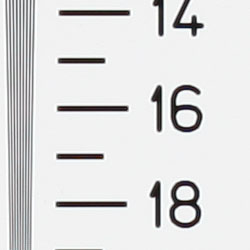 |
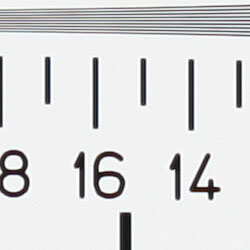 |
| Strong detail to 1,650 lines horizontal | Strong detail to 1,500 lines vertical |
See full set of test images with explanations
See thumbnails of all test and gallery images
Sharpness & Detail
Sharp images with strong detail.
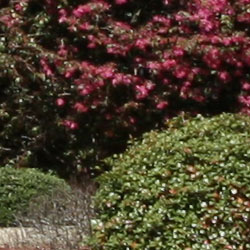 |
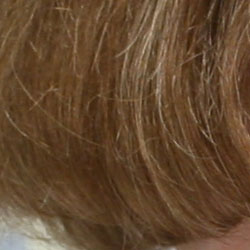 |
| Good definition of high-contrast elements. | Subtle detail: Hair Noise suppression tends to blur detail in areas of subtle contrast, as in the darker parts of Marti's hair here. |
The EOS 30D's images are nice and sharp, only minimal over-sharpening and edge enhancement on the camera's part. (Edge enhancement creates the illusion of sharpness by enhancing colors and tones right at the edge of a rapid transition in color or tone.) The edge profile of the 30D appears to be slightly more rounded and broader than that of the 20D, but the two are very close.
Noise-suppression systems in digital cameras tend to flatten-out detail in areas of subtle contrast. The effects can often be seen in shots of human hair, where the individual strands are lost and an almost "watercolor" look appears. The crop at far right shows this only slightly, with darker areas of Marti's hair showing slightly limited detail, though there is still good definition in the individual strands. (The 30D does better in this respect than many cameras, particularly at higher ISO settings.)
ISO & Noise Performance
Low to moderate noise, with strong detail, even as high as ISO 800. But much higher noise with strong blurring at the highest sensitivity settings.
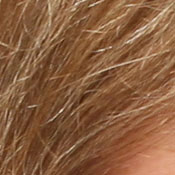 |
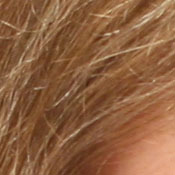 |
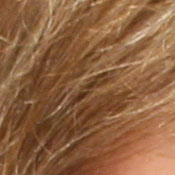 |
| ISO 100 | ISO 200 | ISO 400 |
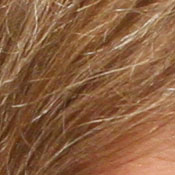 |
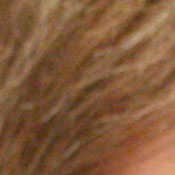 |
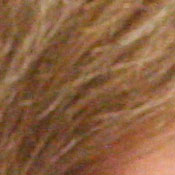 |
| ISO 800 | ISO 1,600 (Sorry blurred due to subject motion) |
ISO 3,200 |
The Canon EOS-30D produces low to moderate noise, without much interference in detail definition all the way up to ISO 800. However, at ISO 3,200, noise is much higher and the resulting images quite blurry all over, with very little visible fine detail.
Extremes: Sunlit and low light tests
Excellent detail and resolution, with strong detail in the shadows and good overall color, better than average highlight handling. Excellent low-light performance as well, capable of capturing bright images in near total darkness.
| +0.3 EV | +0.7 EV | +1.0 EV |
Sunlight:
Because digital cameras are more like slide film than negative film (in that they tend to have a more limited tonal range), we test them in the harshest situations to see how they handle scenes with bright highlights and dark shadows, as well as what kind of sensitivity they have in low light. The shot above is designed to mimic the very harsh, contrasty effect of direct noonday sunlight, a very tough challenge for most digital cameras. (You can read details of this test here.)
The EOS 30D handled this challenge very well, producing only slightly high contrast (even with its contrast adjustment dialed down a couple of notches), but good detail in the highlights and shadows. I chose the +0.7 EV exposure adjustment, though you could certainly use the +0.3 EV setting and adjust the contrast and brightness a little. (In "real life" though, be sure to use fill flash in situations like the one shown above; it's better to shoot in the shade when possible.)
Low light:
The EOS 30D handled our low-light shooting challenge very well, with good color from the Auto white balance system, and good exposures at the lowest light level we test at. The camera's autofocus system also performed very well, able to focus on the subject down to the 1/8 foot-candle light level easily, and almost down to the 1/16 foot-candle level. The bright AF-assist light lets the camera focus on nearby objects in complete darkness. All in all, really excellent low-light capability.
Color
Saturation & Hue Accuracy
Bright, appealing, hue-accurate color, very good results under a wide range of conditions.
| In the diagram above, the squares show the original color, and the circles show the color that the camera captured. More saturated colors are located towards the periphery of the graph. Hue changes as you travel around the center. Thus, hue-accurate, highly saturated colors appear as lines radiating from the center. |
The other important part of color rendition is hue accuracy. Hue is "what color" the color is. Here, the EOS 30D also performed well, though it did shift blue toward cyan to a little (a common tactic to improve sky colors), but results overall were among the most accurate of all the cameras we've tested, and very pleasing.
Our random "Gallery" shots showed very pleasing color across a wide variety of subjects.
Viewfinder
Coverage
Good accuracy from the optical viewfinder.
| Optical Viewfinder |
The EOS 30D's optical viewfinder showed about 95% frame accuracy, which meets Canon's specifications. This level of accuracy is quite typical of lower- and midrange digital SLRs, but we'd really like to see 100% viewfinders even on consumer cameras. (Why can't/won't camera companies do this?)
Flash
Coverage and Range
Good coverage with the built-in flash, about average positive exposure compensation required to boost exposure.
| Normal Flash +1.0 EV | Slow-Sync Flash +1.0 EV |
On the Indoor test, the EOS 30D's flash underexposed our subject at its default setting, requiring a +1.0 EV exposure compensation adjustment to get bright results (quite typical for this shot). Results were very similar in the Slow-Sync flash mode, and both shots had a slight warm cast from the background incandescent lighting. Still, overall color is pretty good.
| 8 ft | 9 ft | 10 ft | 11 ft | 12 ft | 13 ft | 14 ft |
1/60 sec f2.8 ISO 100 |
1/60 sec f2.8 ISO 100 |
1/60 sec f2.8 ISO 100 |
1/60 sec f2.8 ISO 100 |
1/60 sec f2.8 ISO 100 |
1/60 sec f2.8 ISO 100 |
1/60 sec f2.8 ISO 100 |
Flash intensity remained about the same throughout our test range, with good power all the way out to the 14 foot distance.
Output Quality
Print Quality
Excellent print quality, great color, excellent resolution. Very sharp 13x19 inch prints. ISO 3200 shots are usable at 8x10 inches, ISO 800 ones look great at 13x19.
Testing hundreds of digital cameras, we've found that you can only tell just so much about a camera's image quality by viewing its images on-screen. Ultimately, there's no substitute for printing a lot of images and examining them closely. For this reason, we now routinely print sample images from the cameras we test on our Canon i9900 studio printer, and on the Canon iP5200 here in the office. (See the Canon i9900 review for details on that model.)
There's no other word for it, the Canon 30D's images made just fantastic looking prints, with excellent detail and sharpness at 13x19 inches. As always, the acid test comes at very high ISO settings, and the 30D did very well there too. Perhaps no surprise, we found that the Canon EOS-5D (with its full-frame sensor and larger pixels relative to the overall image area) did a bit better at very high ISOs, with less-visible chroma noise. That said though, the difference between the two wasn't as great as we had been expecting to see. The EOS-30D does a great job, even when pushed to high ISOs and large output sizes.
Color was also really excellent, very bright and appealing, without looking overdone. (Except perhaps in strong reds.) The Canon EOS-30D just makes great-looking photos, by every measure.
Timing and Performance
Canon EOS 30D Timing
A fast, responsive digital SLR.
| Startup/Shutdown: | |
| Power On to first shot | ~0.1 second |
| Shutter response (Lag Time): | |
Full Autofocus |
0.245 second |
Prefocused |
0.068 second |
Manual Focus |
0.154 second |
| Cycle time (shot to shot) | |
| Normal large/fine JPEG | 0.27 seconds |
| Flash recycling | 3 seconds |
| Continuous mode, High | 0.20 second 5.0 frames/second (28 large/fine frames, 10 RAW files) |
| Continuous mode, Low | 0.33 second 3.0 frames/second (36 large/fine frames, 12 RAW files) |
| Download speed | |
| Windows Computer, USB 2.0 | 1,266 KBytes/sec |
The EOS 30D's performance is very good, with a super speedy startup time and good shutter lag as well. Shot-to-shot cycle times are also very good, at 0.27-second in single-shot mode and a flash recycle time of only three seconds for full power output. (Very good, considering the range and power of the on-camera flash.) The Continuous Shooting modes are also impressive, at about five frames per second in High mode and about three frames per second in Low mode, regardless of resolution setting, with excellent buffer capacity. Download speeds are also quite good. Overall, a fast-shooting camera that should handle a wide range of subjects, from fast-paced sporting events to wiggly babies to unpredictable nature shots.
Battery and Storage Capacity
Battery
The Canon EOS 30D uses a custom rechargeable LiIon battery for power. Because it doesn't have a standard external power connector, we weren't able to conduct our usual power consumption tests on it, but our subjective experience of its battery life was very good.
Indeed, power consumption appears to be an area where Canon has made significant strides relative to the 20D, despite the 30D's much larger LCD display. Canon's own numbers for the EOS 30D indicate that you should be able to get about 1100 shots from a fully-charged battery with the flash off, or 750 shots with the flash used half of the time. Both numbers represent significant increases from the earlier EOS-20D.
Storage
No card is included with the EOS 30D, although it accepts CompactFlash memory cards.
512MB Memory Card |
RAW | Fine | Fine | |
| 3,504 x 2,336 | Images | 47 | 102 | 203 |
| File Size | 10.9 MB | 5.0 MB | 2.5 MB | |
| 2,544 x 1,696 | Images | - | 179 | 358 |
| File Size | - | 2.9 MB | 1.4 MB | |
| 1,728 x 1,152 | Images | - | 322 | 645 |
| File Size | - | 1.6 MB | 794 KB | |
I strongly recommend buying at least a 512 MB card, preferably a 1GB one, to give yourself extra space for extended outings.
Conclusion
| Pro: | Con: |
|---|---|
|
|
| Free Photo Lessons | |
|
Reader Comments! --> Visit our discussion forum for the Canon EOS 30D!


Follow Imaging Resource: